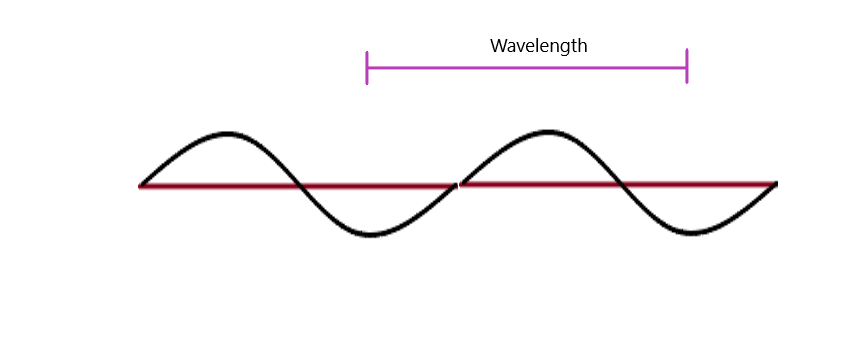
Answer
475.5k+ views
Hint: The relation between wavelength, speed, and frequency is given in the formula used section. Also $km={{10}^{3}}{{m}^{{}}}$ and $MHz={{10}^{6}}Hz$. The wavelength is the distance between two consecutive maxima or two consecutive minima and frequency is the inverse of time between two consecutive maxima and minima.
Formula used:
$v=\lambda f$ where, $v$ is speed, $\lambda $ is wavelength and $f$ is frequency.
Complete step by step answer:
A figure of a typical wave can be seen in the figure below:

We can find the wavelength of the sound wave by the given formula,
$v=\lambda f$
Or
$\lambda =\dfrac{v}{f}$
Putting $v=1.7\times {{10}^{3}}$$m-{{s}^{-1}}$ and $f=4.2\times {{10}^{6}}$Hz
We will get,
$\lambda =\dfrac{1.7\times {{10}^{3}}}{4.2\times {{10}^{6}}}$
This gives us,
$\lambda \approx 0.405\times {{10}^{-3}}$m
Or 0.405 mm.
Additional Information
Ultrasound or ultrasonic waves are the sound waves that have a frequency higher than 20,000 Hz.
The audible range for human ears is 20 Hz-20,000 Hz frequency.
The waves which have a frequency below 20 Hz are called infrasonic waves.
As humans age, they usually lose the ability to hear higher frequency sounds.
Bats can hear and produce ultrasonic waves, which they use to locate their prey during night time.
Dogs can also hear ultrasonic waves and whistles emitting ultrasonic sound waves are used for special training of dogs.
Ultrasonic sound waves are used in Sound Navigation and Ranging (SONAR) systems, to study underwater phenomena.
Infrasonic waves are used to monitor underground earthquakes and volcanic activities.
Generally, women have higher frequency voices as compared to men.
Sound waves require a medium to travel, they cannot travel in a vacuum.
Sound waves follow the laws of reflection.
Sound waves are longitudinal in nature, i.e. the vibration of the medium particle is parallel to the direction of the propagation of the wave.
Just like other waves, sound waves can experience diffraction and interference.
The higher the frequency, the higher is the energy of the wave.
The unit of the loudness of sound is called decibel (dB).
Sounds above 80 dB can be called noise.
Note:
Students must take care of the prefix of the units. E.g. confusing km as m and MHz as hertz will give wrong answers. We can remember the formula from a simple definition of velocity i.e. $speed=\dfrac{displacement}{Time}$. For a wave, the wavelength is displacement and the frequency is the reciprocal of the time period.
Formula used:
$v=\lambda f$ where, $v$ is speed, $\lambda $ is wavelength and $f$ is frequency.
Complete step by step answer:
A figure of a typical wave can be seen in the figure below:

We can find the wavelength of the sound wave by the given formula,
$v=\lambda f$
Or
$\lambda =\dfrac{v}{f}$
Putting $v=1.7\times {{10}^{3}}$$m-{{s}^{-1}}$ and $f=4.2\times {{10}^{6}}$Hz
We will get,
$\lambda =\dfrac{1.7\times {{10}^{3}}}{4.2\times {{10}^{6}}}$
This gives us,
$\lambda \approx 0.405\times {{10}^{-3}}$m
Or 0.405 mm.
Additional Information
Ultrasound or ultrasonic waves are the sound waves that have a frequency higher than 20,000 Hz.
The audible range for human ears is 20 Hz-20,000 Hz frequency.
The waves which have a frequency below 20 Hz are called infrasonic waves.
As humans age, they usually lose the ability to hear higher frequency sounds.
Bats can hear and produce ultrasonic waves, which they use to locate their prey during night time.
Dogs can also hear ultrasonic waves and whistles emitting ultrasonic sound waves are used for special training of dogs.
Ultrasonic sound waves are used in Sound Navigation and Ranging (SONAR) systems, to study underwater phenomena.
Infrasonic waves are used to monitor underground earthquakes and volcanic activities.
Generally, women have higher frequency voices as compared to men.
Sound waves require a medium to travel, they cannot travel in a vacuum.
Sound waves follow the laws of reflection.
Sound waves are longitudinal in nature, i.e. the vibration of the medium particle is parallel to the direction of the propagation of the wave.
Just like other waves, sound waves can experience diffraction and interference.
The higher the frequency, the higher is the energy of the wave.
The unit of the loudness of sound is called decibel (dB).
Sounds above 80 dB can be called noise.
Note:
Students must take care of the prefix of the units. E.g. confusing km as m and MHz as hertz will give wrong answers. We can remember the formula from a simple definition of velocity i.e. $speed=\dfrac{displacement}{Time}$. For a wave, the wavelength is displacement and the frequency is the reciprocal of the time period.
Recently Updated Pages
Master Class 9 Maths: Engaging Questions & Answers for Success

Master Class 9 General Knowledge: Engaging Questions & Answers for Success

Class 10 Question and Answer - Your Ultimate Solutions Guide

Master Class 10 Science: Engaging Questions & Answers for Success

Master Class 10 Maths: Engaging Questions & Answers for Success

Master Class 9 Social Science: Engaging Questions & Answers for Success

Trending doubts
Pigmented layer in the eye is called as a Cornea b class 11 biology CBSE

Proton was discovered by A Thomson B Rutherford C Chadwick class 11 chemistry CBSE

What organs are located on the left side of your body class 11 biology CBSE

The lightest gas is A nitrogen B helium C oxygen D class 11 chemistry CBSE

How many squares are there in a chess board A 1296 class 11 maths CBSE

What are ekaboron ekaaluminium and ekasilicon class 11 chemistry CBSE




